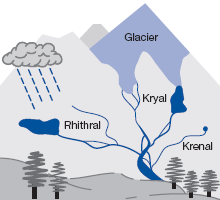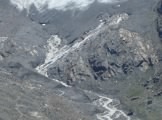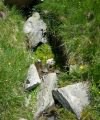 |
|
|
|
|
|
|
In contrast to streams at lower elevations, alpine streams are rather cold. The substratum is predominantly bedrock,
boulder and cobble, and the surrounding vegetation is sparse or absent. Therefore, leaf litter which is a major energy source in
forested mountain streams is negligible in alpine streams. |
|
1 - Alpine stream types and their major water sources (from Hieber et al. 2002) |
There are three primary types of alpine streams which differ in abiotic conditions: kryal streams are fed by
glacial meltwater, rhithral headwaters are fed mainly by rain and snowmelt runoff, krenal streams have
ground water sources.
|
|
||||||||||||||||||||||||||||||||||||||||
|
Alpine floodplains often consist of a mixture of different streamtypes, therefore providing various habitats and ecological niches. |
29 August 2011 |
||
| |
||



